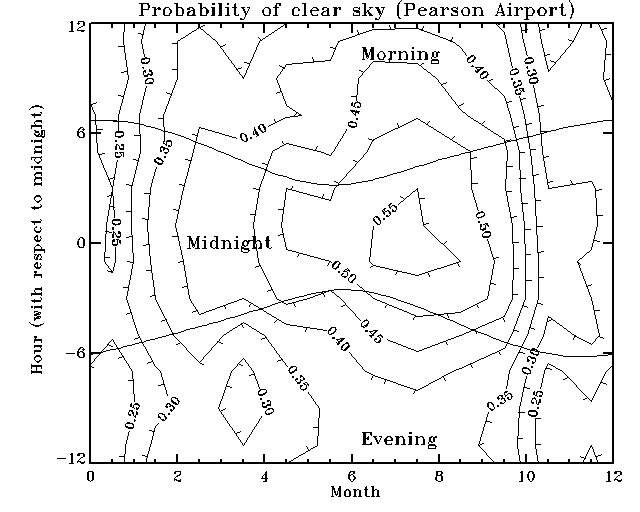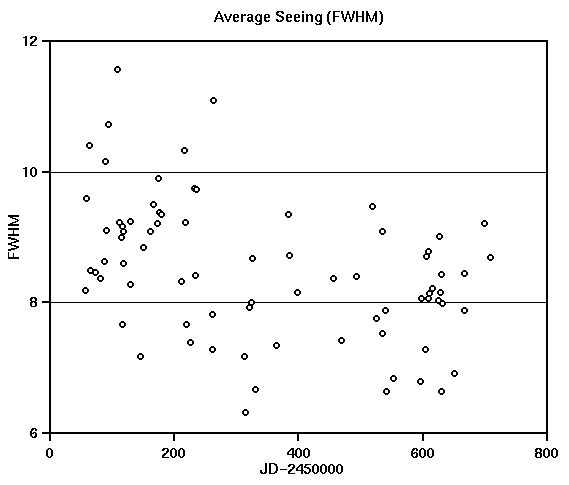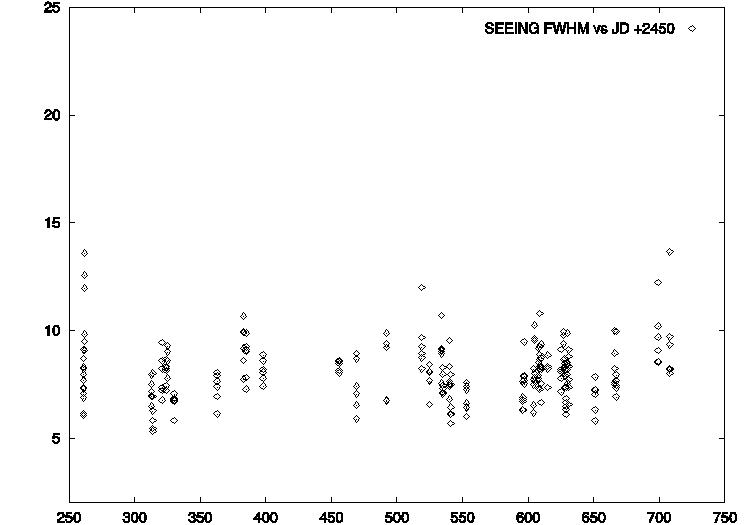- The observing efficiency, in terms of weather
conditions, is roughly 1/3. According to our records for 6 years, July 1999 - June
2005, observing was done on typically 60 - 70% of all scheduled
nights with an average duration of the night of 5.7 - 6.3 hours. We
conduct exclusively spectroscopic projects which are possible on partly
cloudy and cirrusy nights. Our observers and telescope operators are
eager to observe and frequently try to utilise every possible clear
patch on the sky. In terms of actual hours used for observing (compared
with the total expected between the nautical twilight of 3459 hours),
including all technical problems, vacations of the staff etc., the
overall efficiency was 25 - 35%. Thus, an assumption that there is
about 1/3 chance of reasonable spectroscopic observing is usually a
good one.
- The cloud cover shows a seasonal effect in that the
winter nights are definitely more cloudy. They are also much longer
than summer nights so that, if a night is clear, then much more
observing can be done. Very useful information on the monthly and hourly variation in cloudiness in
years 1990 - 1999 have been provided to us by Mr. Robert Morris,
Meteorological Service of Canada, Environment Canada. The data apply to
the Pearson Airport, not to the DDO site, so that they can only give an
idea about the seasonal and daily variations (see
the graph below). The Pearson Airport is within the snow-belt zone
around Toronto so that clouds and flurries are more frequent there
during the winter months than at the DDO.
- Seasonal effects are moderate. In the summer, the
jet stream migrates far to the North of Toronto and we get hot and
humid air from the South; nights are clear then, but the transparency
may be poor. In the winter, when the jet stream is to the South of
Toronto and we get winter snow (or freezing rain) storms, the cold
arctic air may bring excellent clear skies, but with occasional "lake
effect" clouds from Lake Huron and Georgian Bay. These clouds are
pockets of high moisture swept by the NW winds from these two lakes.
The lake effect clouds produce occasional very heavy precipitation in
the "snow belt" around Toronto. Similarly to Toronto, DDO is outside of
the belt and the winter precipitation is moderate; nevertheless, DDO
does get a bit more snow than the downtown of Toronto.
- Our Telescope Operators use several weather Web resources to monitor the
weather, including the satellite images and radar images, so that
relatively little time is lost due to weather uncertainties.
- Some data on the frequency of photometric weather
is available in the form of a short article by Don Fernie in Jour. Roy.
Astr. Soc. Canada, Vol.66, No.5, p.249 (1972). He estimated that there
are 580 hours of photometric weather per year. This looks like a quite
good number to the undersigned because my impression is that we have
frequent cirrus clouds associated with the jet stream. Don stated that
a good photometric site would typically give 2000 hours per year.
- Monitoring of the seeing was done at the DDO for
many years. It is not continued currently (1999 -), but good data have
been collected before and we can use them. According to some sources,
the seeing is actually constantly improving due to the influence of the
big city and its thermal effects. The seeing monitoring was done
through a rather elaborate procedure involving direct CCD images in the
focal plane which were subsequently analysed for the FWHM Gaussian
widths.
- While for long time various ways of controlling the
seeing gave relatively small improvements, a big improvement was
observed a few years ago, on JD2,450,255, when additional insulation of
the mirror cell was installed inside the telescope. This reduced the
seeing FWHM from about 9.5pix to 8.0pix, where 1pix = 0.223 arcsec.
Thus, at present, we have median seeing typically at the level FWHM =
1.7 arcsec (see the figures below). The most frequently used slits in
the Cassegrain spectrograph are 1.5 and 1.8 arcsec wide.
- Seeing as good as 1.0 arcsec was observed for several
months in the Spring of 1999 and it then became clear that one
arcsec is approximately the level of the image quality given by the
mirror itself. Manufacturer's records related to the accuracy of
figuring of the mirror confirm this number.
- Seing as poor as 5 - 8 arcsec is also known to appear from
time to time, especially during very cold winter nights.

Probability of clear sky versus month (x-axis) and time-of-day (y-axis)
for 1990 - 1999 based on the Toronto Pearson Airport data. The wavy
lines give the times of nautical twilight at the DDO. Note that summer
nights are short, but offer probability of clear skies better than 50%
(July and August are particularly good). Toronto is most cloudy in
December/January and in March in the afternoon. However, the Airport
data for the winter months are somewhat pessimistic because the DDO
site is less affected by the lake-effect clouds than the Pearson
Airport.

Improvement in the seeing after installation of the internal insulation
at JD2,450,255. One pixel equals 0.223 arcsec.

Typical data on the seeing after installation of the insulation (the
jump is at the left end of the diagram). One pixel equals 0.223 arcsec.

Histogram of the seeing after installation of the insulation. One pixel
equals 0.223 arcsec.
|